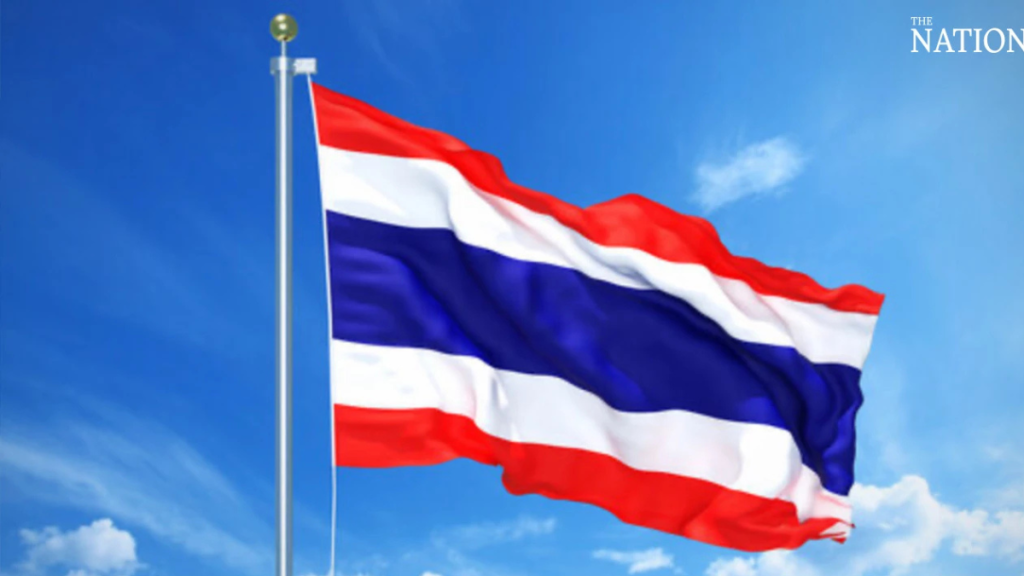
thailand flag
Table of Contents
The Thailand flag is more than just a national symbol. It represents the country’s rich history, cultural values, and deep-rooted traditions. The iconic tricolor design carries significant meaning, embodying the spirit and unity of the Thai people. Understanding the story behind the Thailand flag offers a deeper appreciation of its significance and how it continues to shape national identity.
The Design and Colors of the Thailand Flag
The Thailand flag is instantly recognizable due to its striking red, white, and blue stripes. These colors are not chosen at random; each holds deep significance. The flag features five horizontal stripes arranged symmetrically. The outermost stripes are red, followed by white, with a bold blue stripe in the center.
Red symbolizes the nation’s strength and the sacrifices made by its people throughout history. White represents purity and Buddhism, which plays a central role in Thai culture. Blue stands for the monarchy, which has been a unifying force in the country. The combination of these colors showcases the balance between the people, the religion, and the king.
The simplicity of the Thailand flag does not take away from its powerful symbolism. Each time it is raised, it reminds Thai citizens of their shared heritage and the values that bind them together. The design reflects not only national pride but also a commitment to unity and peace.
The History Behind the Thailand
The Thailand flag has evolved over time, reflecting the country’s changing political and cultural landscape. The earliest versions of the flag date back to the Ayutthaya Kingdom, where flags were used mainly for naval and military purposes. These early flags bore different symbols, including a plain red background, which was commonly used in the 17th century.
In the 19th century, during the reign of King Rama IV, the Thailand flag began to take on a more standardized design. A white elephant was added to the red background, symbolizing strength, wisdom, and prosperity. The white elephant was considered sacred in Thai culture, making it a fitting emblem for the nation.
It was not until 1917, under King Rama VI, that the modern Thailand flag was officially adopted. The previous version, featuring an elephant, was replaced with the current tricolor design. This change was made to create a flag that was easy to recognize and aligned with contemporary national values. The new flag was named the Triranga, meaning “tricolor” in Thai, and has remained unchanged ever since.
The Importance of the Thailad Flag in Culture
The Thailand flag is deeply woven into the country’s cultural fabric. It is more than just a national emblem; it represents a way of life. Thai people take immense pride in their flag, and it is prominently displayed in schools, government buildings, and public spaces.
National celebrations often feature the Thailand flag, waving proudly during parades and official ceremonies. It is a key symbol during major holidays, including the King’s Birthday and National Day. Schools instill respect for the flag from an early age, teaching children the significance of standing during the national anthem while the flag is raised.
The respect for the Thailand flag extends beyond official events. Many homes and businesses display the flag as a sign of national pride. It is common to see it flown alongside the portraits of the King, emphasizing the deep connection between the monarchy and the people.
The Thand Flag in Times of Crisis
The Thailand flag has played a crucial role in uniting the country during difficult times. It has been a source of strength during wars, political unrest, and natural disasters. Throughout history, Thai citizens have rallied under their flag, using it as a symbol of resilience and hope.
During times of national crisis, the Thailand flag becomes a powerful emblem of unity. Whether in response to natural disasters or economic hardships, it is a reminder that the Thai people stand together. It has been carried in protests, flown in remembrance of fallen heroes, and displayed as a sign of solidarity in times of struggle.
The flag has also been a source of inspiration for military and humanitarian efforts. Soldiers wear the colors with pride, knowing they represent the strength and spirit of their nation. Aid organizations often display the flag to show their commitment to helping Thai citizens in need.
The Role of the Thaland Flag in International Relations
The Thailand flag is an important part of the country’s presence on the global stage. It is proudly displayed at international events, from diplomatic meetings to sporting competitions. When Thai athletes compete, the flag is raised in victory, symbolizing national pride and achievement.Embassies around the world fly the Thailand flag to represent the nation’s sovereignty and its diplomatic ties with other countries. It is a key identifier in the global community, showcasing Thailand’s unique cultural identity and political stance.
Proper Etiquette and Respect for the Thailad Flag
Thai culture places great importance on respect for national symbols, and the Thailand flag is no exception. There are specific guidelines on how the flag should be handled, displayed, and used. Thai citizens are taught from a young age that the flag must be treated with the utmost respect.
It is customary to stand when the national anthem is played while the Thailand flag is raised or lowered. The flag should never touch the ground, and it must always be flown in good condition. Damaged or faded flags are replaced to maintain the dignity of the national symbol.
Improper use of the Thailand flag can be considered offensive. It is not permitted to use the flag for commercial purposes or in a manner that disrespects its symbolism. These strict guidelines reinforce the deep reverence that Thai citizens have for their national flag.
The Thailand Flag and National Identity
The Thailand flag is more than just a piece of fabric; it is a powerful representation of the nation’s identity. It embodies the values, history, and aspirations of the Thai people. The red, white, and blue stripes remind citizens of their unity and resilience, while also paying homage to the monarchy and religious traditions.
For Thai people, seeing their flag evokes a sense of pride and belonging. It is a constant reminder of their shared heritage and the responsibilities that come with being a citizen. The flag is a unifying force, bringing people together regardless of differences in background or beliefs.
Conclusion
The Thailand flag is a significant part of the nation’s history and culture. Its bold tricolor design carries deep meanings, symbolizing the people, the monarchy, and Buddhism. From its historical evolution to its role in modern-day Thailand, the flag remains an enduring emblem of national pride.



